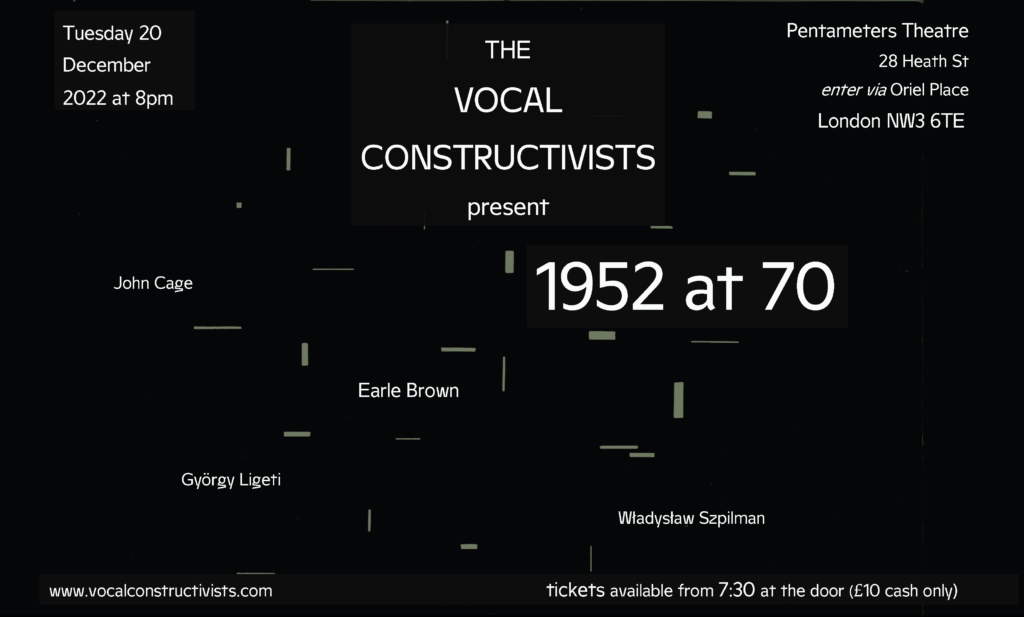

In 1952, London experienced the Great Smog, ‘McCarthyism’ swept the United States, a tidal wave hit Hawaii, a pint of beer cost 1s 9½ d, the Flower Pot Men started on British children’s television, and A Streetcar Named Desire won four Academy Awards. The year witnessed the composition of a range of very special musical pieces, in Budapest, New York, and Warsaw, and the birth of a founder member of the Vocal Constructivists. Alison Cross (middle name Elizabeth) started making art as early as possible. After studying philosophy at university, she became a professional artist in 1985 and did well until the recession bit. She taught part-time at Camberwell Art School, then at the University of Greenwich, for Animation and Film & TV Production.
Between 1950 and 1952, the American composer Earle Brown began experimenting with different kinds of sketches of scores that would allow for free realizations of a sonic image. Morton Feldman and John Cage were also exploring new notational possibilities and higher degrees of spontaneity in performances of their pieces. ‘At this time’, Brown later wrote, ‘I was considering and had conceived of the idea of two kinds of mobility: one the physical mobility of the score itself, and the other the conceptual mobility – which is to say the performer’s mental approach to the piece – holding in mind the considerable number of different ways of moving, moving the mind around a fixed kind of graphic suggestion, or actually physically moving the score itself. December 1952 specifically is a single page, something like a photograph of a certain set of relationships of these various horizontal and vertical elements’.
Cage identified Feldman’s music as a prime example of a non-relational spontaneity that accepted ‘whatever sounds come along’. In tonight’s concert, three of Feldman’s 1952 piano pieces are performed alongside one of the rounds György Ligeti wrote in Budapest after the Second World War. Under Soviet rule, modernist tendencies were outlawed and Hungarian composers were expected to write in a folk-based style. Pletykázó asszonyok (The Gossips) is a setting of a text by Sándor Weöres: ‘Auntie Julie, Auntie Cathy, natter chatter natter chat; sit together for prattle, and my goodness, how they tattle! Natter chatter natter chat! “Have I told you natter chatter?” “No, not yet” “Oh dear: natter chatter natter!” “Is that so? Did you see it with your own eyes, natter chatter natter chat?” “It was torn right in the middle, how it happened is a riddle!” “Oh! Oh! Oh, natter chatter natter chat, natter chatter chat!”’
4′ 33″ is probably Cage’s most famous piece. In his 1951 ‘Lecture on Something’, Cage described the creative freedom he was experiencing from his embrace of silence. At the first performance, David Tudor sat at the piano, opened the keyboard lid, and sat silently for 33 seconds. He then closed the lid, reopened it, and sat for two minutes and 20 seconds. He closed and reopened the lid a third time, sitting silently for one minute and 40 seconds. Finally, he closed the lid and walked off stage. The Vocal Constructivists perform this piece in memory of the artist Tom Phillips and founder member Celia Springate.
The flute player Otto Luening and pianist Vladimir Ussachevsky were already well established as instrumental and orchestral composers when they began a series of experiments with a simple tape machine, a pair of headphones and a primitive mixing box, which led to the first electronic/tape pieces composed in the United States. Luening and Ussachevsky discovered and developed the techniques of speed transposition, playback recording, mixing and splicing, and composed a series of tape works, which they performed on 28 October, 1952 at the Museum of Modern Art in New York City. The Vocal Constructivists retro-engineer these pieces for live performance.
In the chorus of Polish composer Władysław Szpilman’s 1952 hit, Czerwony Autobus, Kazimierz Winkler’s lyrics celebrate the symbolic Red Bus as a welcoming beacon in the reconstruction of post-war Warsaw: ‘The red bus glides along the streets of my city / Passes the bright new houses, and gardens’ cool shade / Sometimes a girl will cast us a glance like a fiery flower, New is not only the New World — here, each day is new. The engine buzzes, a rumbling bass over the bridge / In a tone of joy, where my heart sings / The red bus, and in it, people, each and every one / Looking like they just saw their city for the first time’. The VCs re-texted the song to celebrate a local favourite, welcoming the electric rumblings of the 46 in our 4’33”. Pentameters Theatre, run by the remarkable poet/curator Léonie Scott-Matthews and Godfrey Old, plays an active part in expanding recognition of creative work. This intimate space helps to foster and enrich creativity in the heart of historic Hampstead.

